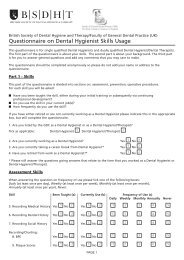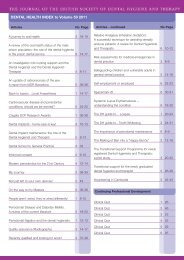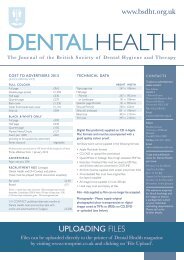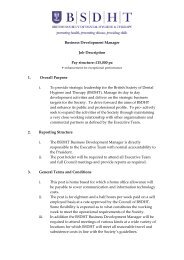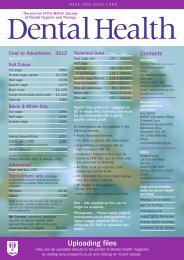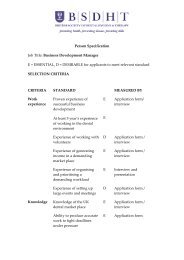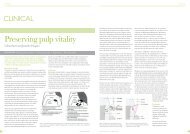Dental Health - British Society of Dental Hygiene & Therapy
Dental Health - British Society of Dental Hygiene & Therapy
Dental Health - British Society of Dental Hygiene & Therapy
- No tags were found...
Create successful ePaper yourself
Turn your PDF publications into a flip-book with our unique Google optimized e-Paper software.
cpdSelf Assessment for CPD Select one correct answer in each questionCPD questions November 2012Worth1 hour <strong>of</strong>verifiableCPDCPD paper 1: Setting the stage for implants, pages 12-15Q1. A tooth is extracted, and socket preservationhas not been carried out. In such a case, which <strong>of</strong>the following statements is false?A. The bone resorbsB. There may be a detrimental affect on facial structureC. The alveolar ridge does not retain its shapeD. A denture is the only option to replace the missingteethQ2. Which <strong>of</strong> the following statements is true <strong>of</strong>adjunctive procedures?A. Can be used after implant placement to regeneratebone lost around implantsB. Cannot regenerate bone height and width to placeimplant(s) in the optimal locationC. Are only performed prior to placing implantsD. Are carried out by a dental hygienistQ3. What is a GBR?A. Generalised bone reductionB. Generalised bone regenerationC. A bone regeneration procedure that allows bone toregenerate while keeping the connective tissue outD. A bone regeneration procedure that allows bone toregenerate while keeping the connective tissue inQ4. What are the principles <strong>of</strong> regenerativeproducts?A. Osteogenesis, osteoreductive, osteoinductiveB. Osteoclastic, osteoconductive, osteoinductiveC. Living cells; scaffold to allow bone to regenerate;signals to isolate and accelerate regenerationD. Eliminate the need for surgical proceduresQ5. How long does it normally take for granulationtissue to fill the socket?A. 6 days B. 6 weeksC. 6 months D. 12 monthsQ6. What is a xenograft?A. A bone graft typically derived from a different species,typically bovine or porcine graftsB. A bone graft which is always osteoreductiveC. A synthetic bone graft used in regeneration andpreservation proceduresD. A synthetic bone graft manufactured entirely inthe UKCPD paper 2: Comparisons and management <strong>of</strong> tooth wear page 18-19Q1. Which <strong>of</strong> the following is not considered to bean aetiological factor in the process <strong>of</strong> abrasion?A. Over zealous toothbrushing habitsB. Abnormal oral habitsC. Acidic beveragesD Abrasive toothpasteQ2. Which <strong>of</strong> the following statements is true <strong>of</strong>attrition?A. Often caused by parafunctional activityB. Always causes pain and discomfortC. Requires no dental interventionD. Only ever noted in the permanent dentitionQ3. Abfraction may best be described by which <strong>of</strong>the following statements?A. It is a physical processB. It is a chemical processC. It is a physiological processD. It is a biological processQ4. Erosion is the result <strong>of</strong>…?A. Bacterial infection B. Bacterial inflammationC. Bacterial acid D. Non-bacterial acidsQ5. Which <strong>of</strong> the following statements is false?A. Abrasion characteristically affects the buccal surfacesB. Attrition characteristically affects the palatal andocclusal surfacesC. Abfraction characteristically affects the cervicalregionsD. Erosion characteristically affects cervical regionsQ6. <strong>Dental</strong> erosion is caused by sustained directcontact between tooth surfaces and acidicsubstances. It has long been recognized thatdemineralization <strong>of</strong> dental enamel will occur oncethe oral environmental pH reaches the criticalthreshold. What is considered to be the criticalthreshold?A. 2.5 B. 3.5C. 4.5 D. 5.542 <strong>Dental</strong> <strong>Health</strong> Volume 51 No 6 <strong>of</strong> 6 November 2012



